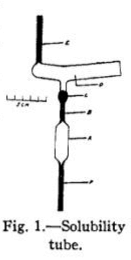Dredging Method
I desire to call the attention of the Institute to a novel system of dredging, which, it seems to me, may prove applicable, not only to river and harbor improvements, but also to certain varieties at least of alluvial and diluvial gold mining; that is, river-mining, bar-mining, coast-mining, and any other similar operations now carried […]
How to Separate Liquid from Solids
For some years past the principle enunciated in the discussion referred to has been known to the writer and demonstrated by him to be an efficient and economical way of separating water or solution from solids in the cyanidation, lixiviation or acid leaching of ore pulps. In utilizing this principle in commercial practice he has […]
Tin Recovery by Gravity Methods
In a tin concentrator an appliance was needed to furnish a suitable product for fine jigging from a pulp of the following composition: In the jigging process, particles of cassiterite as small as 0.1 mm. can be recovered, provided they are not present in excess, that is if the material treated on the jigs contains […]
Gold Bearing Gravel
Discovery of Gold Bearing Gravel in Canada A woman first discovered gold in the Chaudiere Valley near the mouth of Gilbert River. No attention was paid to the discovery, but a young girl named Clothilde Gilbert, taking a horse to water, found in the creek, close to the location of the previous discovery, a nugget of gold […]
Free and Hindered Settling
In his paper entitled, Development of Hindered-Settling Apparatus, Dr. Richards has related the history of the development of the hindered-settling classifier and given illustrations of the several types of this apparatus which he has designed. An earlier paper, Close Sizing Before Jigging, shows the nature of the hindered-settling phenomenon and the results which it produces. […]
Round Tables Recovery of Minerals from Fine & Slimes
During the last half century a great amount of ingenuity and energy has been devoted to the invention of appliances for the recovery of valuable minerals from very fine sands and slimes. The reason for this is that in almost every dressing plant the greatest losses of values, considered relatively as well as absolutely, occur […]
California Gold Dredging
Gold dredging has won an important place in the industry of mining, and it has done so by right of hard-earned merit. Probably no branch of mining has come so prominently to the front in so short a time; by proving its commercial value it has opened to the financier an opportunity for safe and […]
Sorting Classifiers
The purpose of this paper is to present a brief sketch of the development of this hindered-settling “sorting” classifier, but primarily to show the actual results obtained in practice with the classifier working on the Butte copper ores at the Boston & Montana Concentrator at Great Falls and the Washoe Concentrator at Anaconda. The writer […]
Placer Gold Mining in Colombia
In giving my opinion of the importance of Colombia as a field for investment for those interested in mining for the precious metals, I must begin by quoting Sir Clement Markham, who, in one of his presidential addresses to the Royal Geographical Society of Great Britain, called the attention of its members to the fact […]
Solubility Of Gold In Mercury

Although three rather extensive researches on the system gold-mercury have been published within the last ten years, the disagreement in the various results is most remarkable, particularly at lower temperatures. Quite recently rather precise results on the system silver-mercury, using a new type of solubility tube, have been published by Sunier and Hess;* it has […]
